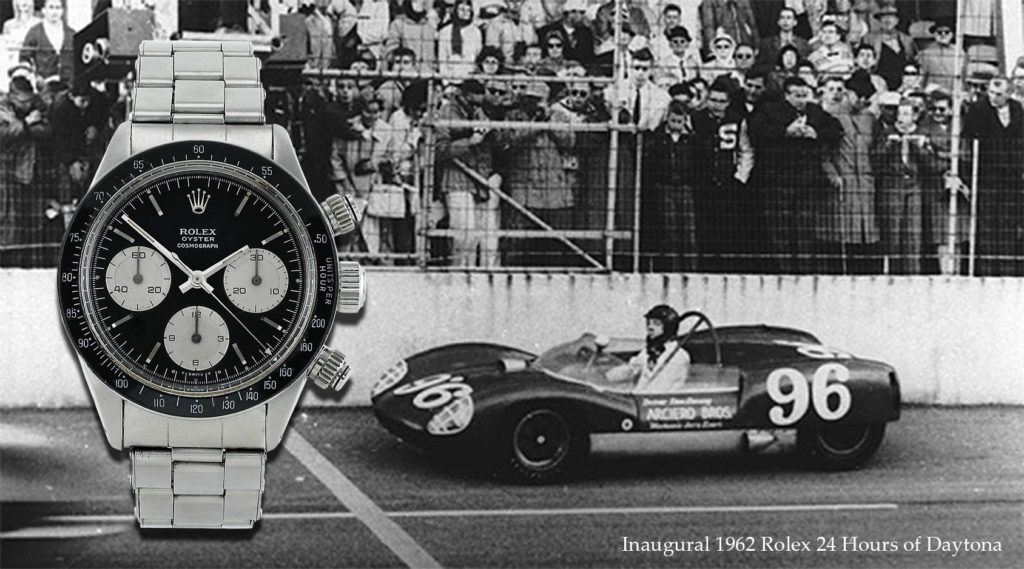Not all Swiss timepieces are created equal, but there are a few brands and models that get everyone excited at deBoulle. As a family who is active and passionate about motorsports and speed, naturally we are partial to the Rolex Cosmograph Daytona and its earlier predecessors.
The name Daytona has become synonymous with racing, as the Florida city has attracted racing enthusiasts for almost a hundred years and is home to the Daytona International Speedway. However, the name is equally recognized in the world of haute horology as one of the most coveted Rolex watches to own. It’s the watch to have in every collection- both big and small. For our very own, Nick Boulle, it has an extra special meaning. Nick won the Rolex 24 Hours of Daytona race in 2017 and was awarded the Rolex Cosmograph Daytona in oyster steel and yellow gold. Traditionally, only steel versions are given to the winners.

To fully understand and appreciate the Rolex Daytona, it’s worth taking a brief history lesson on the fascinating evolution of this revered model.
In 1955, Rolex introduced its first manual winding chronograph, reference 6234 with a Valjoux movement, tachometer scale around the outer ring, and a telemeter scale for distances on the inner ring of the dial. This reference, which could be considered the actual precursor to the Daytona family of watches, was discontinued in 1961. However, most collectors consider the true patriarch of the Daytona family to be reference 6238, which is frequently called the “pre-Daytona” by collectors worldwide. The first series of the reference 6238 didn’t vary that much from its predecessor, but the second series of the reference 6238 adapted the use of baton style hands and faceted hour markers. The telemeter scale was removed from the dial and the famous Valjoux caliber 72 was altered by Rolex and renamed the 72B from 1965-1967. It is important to note that the 6238 was not an Oyster model as the watch was not fitted with either a screw-down crown or pushers. Then, in 1963 Rolex introduced the reference 6239 featuring a tachometer scale engraved on the bezel versus having it printed on the dial which greatly improved legibility. In the first years of production, the bezel graduated up to 300 units per hour whereas the later models featured a graduation of 200 units per hour. The 6239 was offered with a silver dial with black registers or black dial with silver registers. This particular model was not immediately given the name Daytona and in fact, Rolex used the name Le Mans in early advertisements before later giving the watch its legendary moniker. In 1965, the name Daytona began to be printed on the dials, and that same year they also introduced new versions with “exotic” dials. These dials would later become known as the “Paul Newman.” In the early 1970’s, the actor was famously photographed wearing a watch gifted to him by his wife which was fitted with one of these exotic dials.
The next version, reference 6240 was the first waterproof wristwatch with the addition of screw-down pushers and the word “OYSTER” printed between the words “ROLEX” and “COSMOGRAPH” on the dial. The watch also featured a new version of a steel bezel with acrylic insert and white printing for the 200 units per hour tachometer. The 6240 reference was produced until 1969 and was only offered in stainless steel. Today, these have become the rarest of all Daytonas and are coveted by collectors of the brand. Rolex then introduced reference 6241 with an acrylic bezel (like reference 6240), but with pump pushers. This reference was significant in the fact that the word “DAYTONA” was officially printed on the dial. In 1970-1971 Rolex introduced two new Cosmograph Daytona references, the 6262 and 6264, fitted with the new caliber 727 movement. Both references featured pump-style pushers and were fitted with either a stainless steel engraved tachometer bezel (ref. 6262) or stainless steel and acrylic tachometer bezel (ref. 6264) at 200 units per hour. Finally, in 1971 Rolex introduced the last references of the manual winding Daytonas, the 6263 and 6265, which were made in both stainless steel and gold versions. The 6263 and 6265 references featured screw-down pushers, a larger crown (thus improving the waterproofness from 50 to 100 meters) and either a stainless steel and acrylic tachometer bezel (ref 6263) or a stainless steel engraved tachometer bezel (ref 6265.) Finally, in 1987 the watch reference was discontinued in favor of a new model powered by an automatic Zenith movement.

Most of these early Daytonas are difficult to come by, but deBoulle is proactive at sourcing these coveted timepieces. One of our most recent acquisitions is the Cosmograph Daytona, reference 6263 (circa 1974-1975). At the time, it was purchased new by it’s original owner. The watch still retains sharp lugs and is fitted with its original folded Oyster bracelet. Of particular interest on this 6263 is the fact the watch bears a rare T Swiss T Sigma dial and lacks the red Daytona lettering above the bottom register. These dials were produced between 1971-1976 and are coveted by collectors for their rarity. The Greek “Sigma” symbol was printed on the dial “to certify that the goods were of Swiss origin and contained solid gold up to a certain standard.” The Sigma stampings were found anywhere on a watch – the dial, case, bracelet or case back and were used by many other famous brands during this time including Patek Phillippe and Vacheron Constantin. This version of the manual winding Daytona makes for a good daily wearer and is quite robust with it’s Oyster case and screw down pushers and crown. It would look equally as beautiful on a strap as well!
For inquires or more on the history behind Rolex Daytonas, contact a deBoulle sales associate at (214) 522-2400.

